Management Accounting Report: Financial Analysis of Shell Corporation
VerifiedAdded on 2023/01/13
|12
|3150
|77
Report
AI Summary
This report provides a comprehensive analysis of management accounting principles and systems, focusing on Shell Corporation's financial challenges. The report delves into the core concepts of management accounting, including its role in providing information for internal decision-making. It examines various management accounting systems such as inventory management, cost accounting, and price optimization, highlighting their importance in Shell's operations. The report also explores management accounting reporting, including cost reports, performance reports, and inventory reports. Furthermore, the report applies techniques like marginal and absorption costing to analyze income statements and evaluate financial performance. It examines planning tools of budgetary control, discussing the merits and demerits of zero-based budgeting, rolling budgets, and operating budgets. Finally, the report identifies financial problems faced by Shell and suggests appropriate management accounting systems, such as key performance indicators and benchmarking, to address these challenges and improve financial outcomes.

Management
Accounting
Accounting
Paraphrase This Document
Need a fresh take? Get an instant paraphrase of this document with our AI Paraphraser
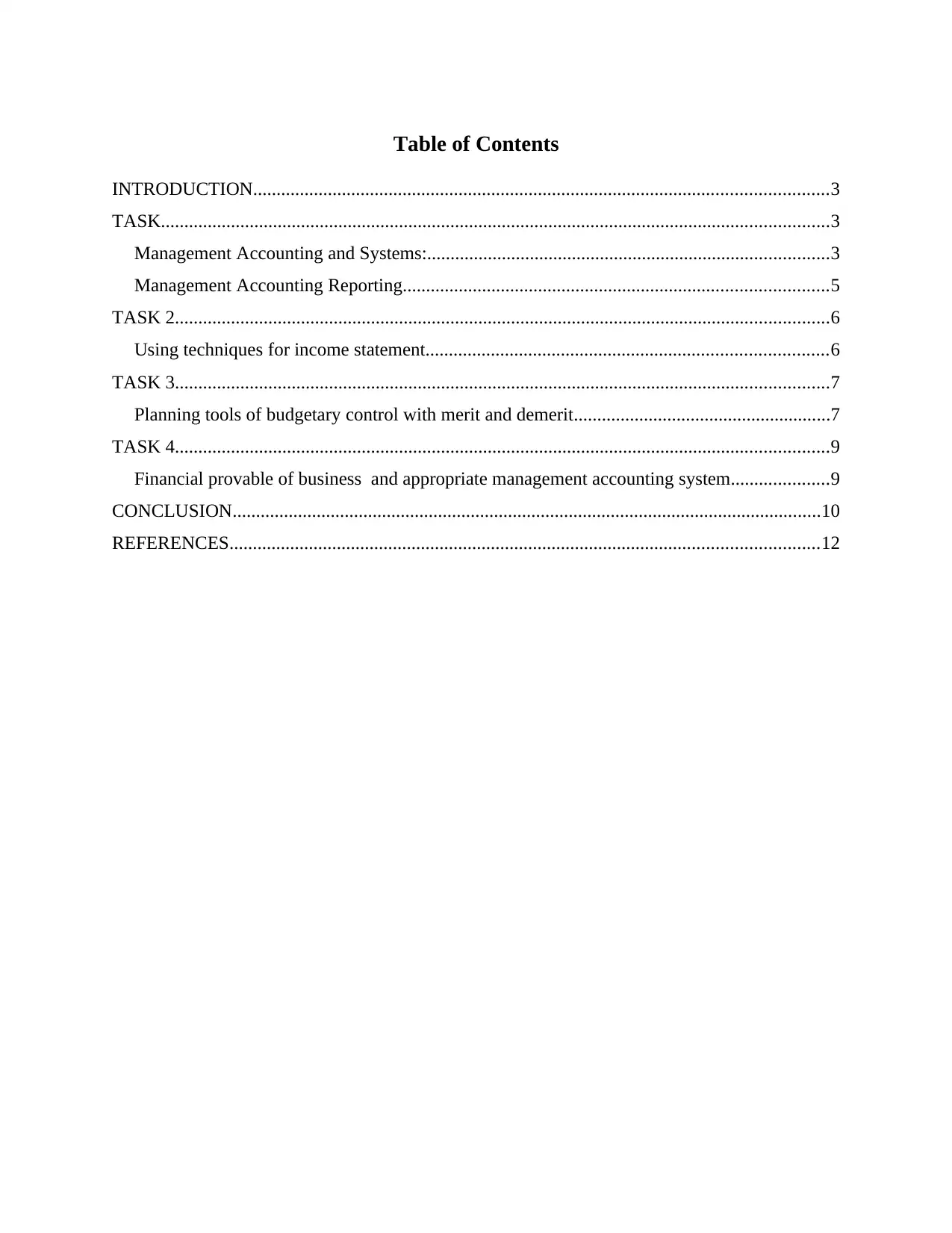
Table of Contents
INTRODUCTION...........................................................................................................................3
TASK...............................................................................................................................................3
Management Accounting and Systems:......................................................................................3
Management Accounting Reporting...........................................................................................5
TASK 2............................................................................................................................................6
Using techniques for income statement......................................................................................6
TASK 3............................................................................................................................................7
Planning tools of budgetary control with merit and demerit.......................................................7
TASK 4............................................................................................................................................9
Financial provable of business and appropriate management accounting system.....................9
CONCLUSION..............................................................................................................................10
REFERENCES..............................................................................................................................12
INTRODUCTION...........................................................................................................................3
TASK...............................................................................................................................................3
Management Accounting and Systems:......................................................................................3
Management Accounting Reporting...........................................................................................5
TASK 2............................................................................................................................................6
Using techniques for income statement......................................................................................6
TASK 3............................................................................................................................................7
Planning tools of budgetary control with merit and demerit.......................................................7
TASK 4............................................................................................................................................9
Financial provable of business and appropriate management accounting system.....................9
CONCLUSION..............................................................................................................................10
REFERENCES..............................................................................................................................12
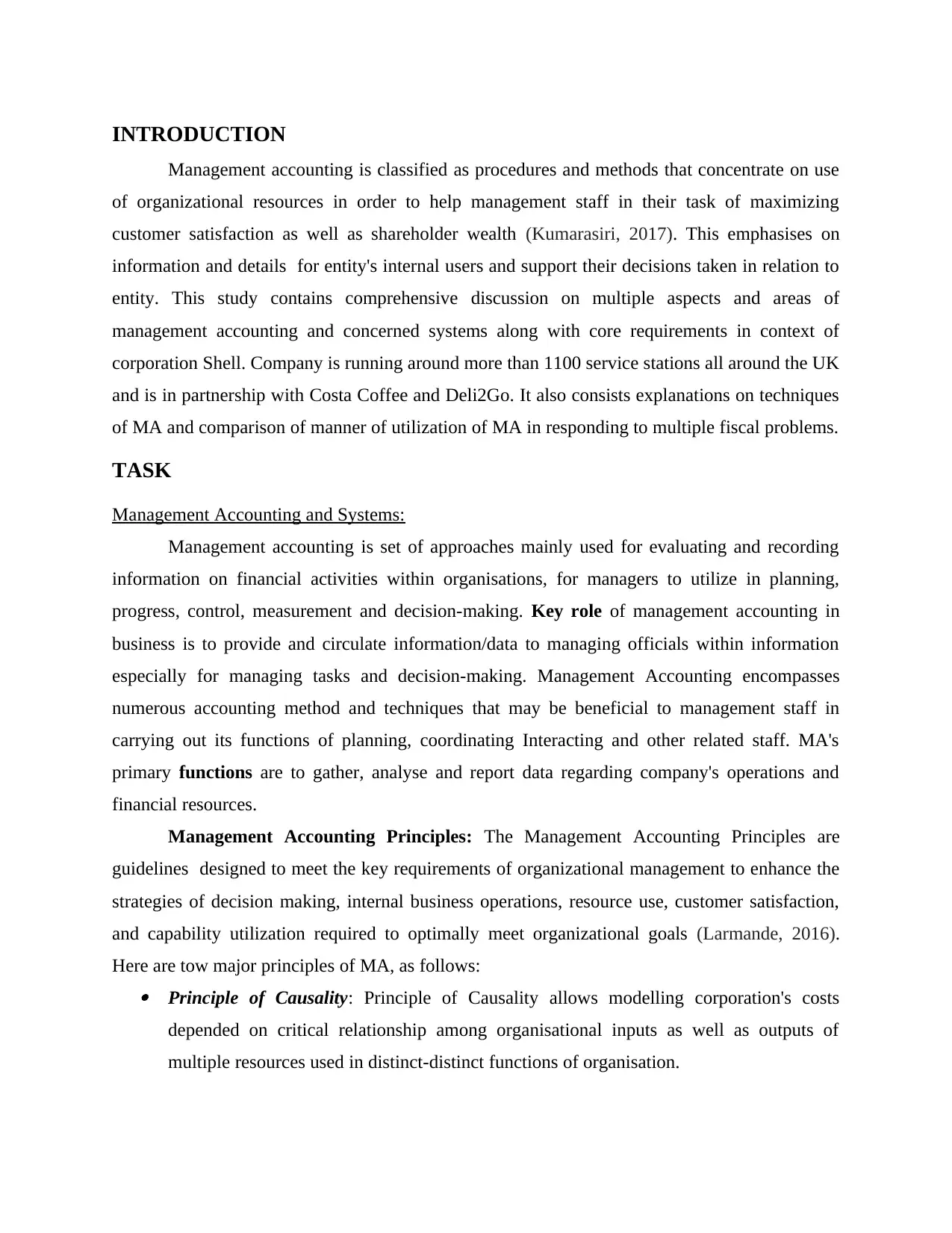
INTRODUCTION
Management accounting is classified as procedures and methods that concentrate on use
of organizational resources in order to help management staff in their task of maximizing
customer satisfaction as well as shareholder wealth (Kumarasiri, 2017). This emphasises on
information and details for entity's internal users and support their decisions taken in relation to
entity. This study contains comprehensive discussion on multiple aspects and areas of
management accounting and concerned systems along with core requirements in context of
corporation Shell. Company is running around more than 1100 service stations all around the UK
and is in partnership with Costa Coffee and Deli2Go. It also consists explanations on techniques
of MA and comparison of manner of utilization of MA in responding to multiple fiscal problems.
TASK
Management Accounting and Systems:
Management accounting is set of approaches mainly used for evaluating and recording
information on financial activities within organisations, for managers to utilize in planning,
progress, control, measurement and decision-making. Key role of management accounting in
business is to provide and circulate information/data to managing officials within information
especially for managing tasks and decision-making. Management Accounting encompasses
numerous accounting method and techniques that may be beneficial to management staff in
carrying out its functions of planning, coordinating Interacting and other related staff. MA's
primary functions are to gather, analyse and report data regarding company's operations and
financial resources.
Management Accounting Principles: The Management Accounting Principles are
guidelines designed to meet the key requirements of organizational management to enhance the
strategies of decision making, internal business operations, resource use, customer satisfaction,
and capability utilization required to optimally meet organizational goals (Larmande, 2016).
Here are tow major principles of MA, as follows: Principle of Causality: Principle of Causality allows modelling corporation's costs
depended on critical relationship among organisational inputs as well as outputs of
multiple resources used in distinct-distinct functions of organisation.
Management accounting is classified as procedures and methods that concentrate on use
of organizational resources in order to help management staff in their task of maximizing
customer satisfaction as well as shareholder wealth (Kumarasiri, 2017). This emphasises on
information and details for entity's internal users and support their decisions taken in relation to
entity. This study contains comprehensive discussion on multiple aspects and areas of
management accounting and concerned systems along with core requirements in context of
corporation Shell. Company is running around more than 1100 service stations all around the UK
and is in partnership with Costa Coffee and Deli2Go. It also consists explanations on techniques
of MA and comparison of manner of utilization of MA in responding to multiple fiscal problems.
TASK
Management Accounting and Systems:
Management accounting is set of approaches mainly used for evaluating and recording
information on financial activities within organisations, for managers to utilize in planning,
progress, control, measurement and decision-making. Key role of management accounting in
business is to provide and circulate information/data to managing officials within information
especially for managing tasks and decision-making. Management Accounting encompasses
numerous accounting method and techniques that may be beneficial to management staff in
carrying out its functions of planning, coordinating Interacting and other related staff. MA's
primary functions are to gather, analyse and report data regarding company's operations and
financial resources.
Management Accounting Principles: The Management Accounting Principles are
guidelines designed to meet the key requirements of organizational management to enhance the
strategies of decision making, internal business operations, resource use, customer satisfaction,
and capability utilization required to optimally meet organizational goals (Larmande, 2016).
Here are tow major principles of MA, as follows: Principle of Causality: Principle of Causality allows modelling corporation's costs
depended on critical relationship among organisational inputs as well as outputs of
multiple resources used in distinct-distinct functions of organisation.
⊘ This is a preview!⊘
Do you want full access?
Subscribe today to unlock all pages.

Trusted by 1+ million students worldwide
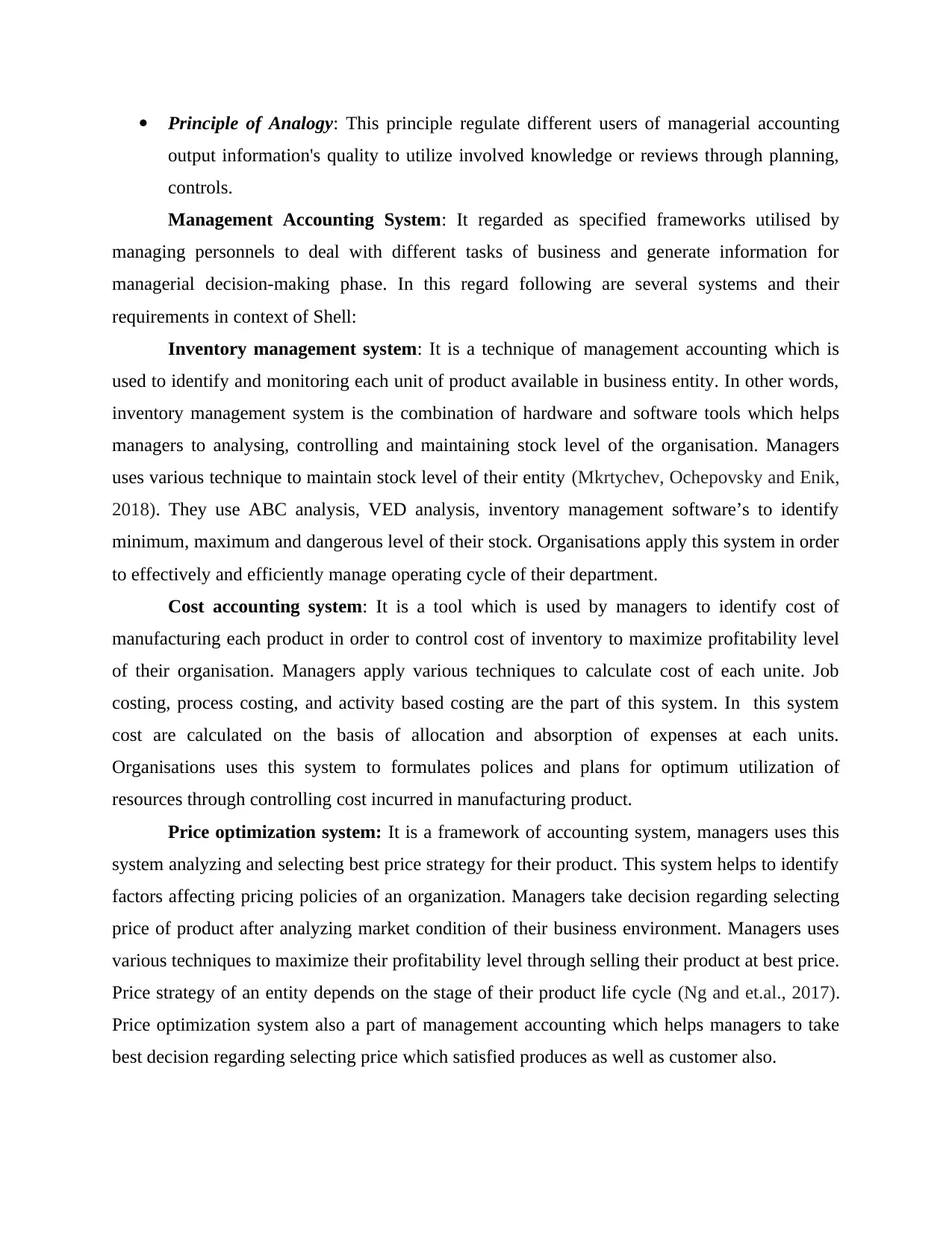
Principle of Analogy: This principle regulate different users of managerial accounting
output information's quality to utilize involved knowledge or reviews through planning,
controls.
Management Accounting System: It regarded as specified frameworks utilised by
managing personnels to deal with different tasks of business and generate information for
managerial decision-making phase. In this regard following are several systems and their
requirements in context of Shell:
Inventory management system: It is a technique of management accounting which is
used to identify and monitoring each unit of product available in business entity. In other words,
inventory management system is the combination of hardware and software tools which helps
managers to analysing, controlling and maintaining stock level of the organisation. Managers
uses various technique to maintain stock level of their entity (Mkrtychev, Ochepovsky and Enik,
2018). They use ABC analysis, VED analysis, inventory management software’s to identify
minimum, maximum and dangerous level of their stock. Organisations apply this system in order
to effectively and efficiently manage operating cycle of their department.
Cost accounting system: It is a tool which is used by managers to identify cost of
manufacturing each product in order to control cost of inventory to maximize profitability level
of their organisation. Managers apply various techniques to calculate cost of each unite. Job
costing, process costing, and activity based costing are the part of this system. In this system
cost are calculated on the basis of allocation and absorption of expenses at each units.
Organisations uses this system to formulates polices and plans for optimum utilization of
resources through controlling cost incurred in manufacturing product.
Price optimization system: It is a framework of accounting system, managers uses this
system analyzing and selecting best price strategy for their product. This system helps to identify
factors affecting pricing policies of an organization. Managers take decision regarding selecting
price of product after analyzing market condition of their business environment. Managers uses
various techniques to maximize their profitability level through selling their product at best price.
Price strategy of an entity depends on the stage of their product life cycle (Ng and et.al., 2017).
Price optimization system also a part of management accounting which helps managers to take
best decision regarding selecting price which satisfied produces as well as customer also.
output information's quality to utilize involved knowledge or reviews through planning,
controls.
Management Accounting System: It regarded as specified frameworks utilised by
managing personnels to deal with different tasks of business and generate information for
managerial decision-making phase. In this regard following are several systems and their
requirements in context of Shell:
Inventory management system: It is a technique of management accounting which is
used to identify and monitoring each unit of product available in business entity. In other words,
inventory management system is the combination of hardware and software tools which helps
managers to analysing, controlling and maintaining stock level of the organisation. Managers
uses various technique to maintain stock level of their entity (Mkrtychev, Ochepovsky and Enik,
2018). They use ABC analysis, VED analysis, inventory management software’s to identify
minimum, maximum and dangerous level of their stock. Organisations apply this system in order
to effectively and efficiently manage operating cycle of their department.
Cost accounting system: It is a tool which is used by managers to identify cost of
manufacturing each product in order to control cost of inventory to maximize profitability level
of their organisation. Managers apply various techniques to calculate cost of each unite. Job
costing, process costing, and activity based costing are the part of this system. In this system
cost are calculated on the basis of allocation and absorption of expenses at each units.
Organisations uses this system to formulates polices and plans for optimum utilization of
resources through controlling cost incurred in manufacturing product.
Price optimization system: It is a framework of accounting system, managers uses this
system analyzing and selecting best price strategy for their product. This system helps to identify
factors affecting pricing policies of an organization. Managers take decision regarding selecting
price of product after analyzing market condition of their business environment. Managers uses
various techniques to maximize their profitability level through selling their product at best price.
Price strategy of an entity depends on the stage of their product life cycle (Ng and et.al., 2017).
Price optimization system also a part of management accounting which helps managers to take
best decision regarding selecting price which satisfied produces as well as customer also.
Paraphrase This Document
Need a fresh take? Get an instant paraphrase of this document with our AI Paraphraser
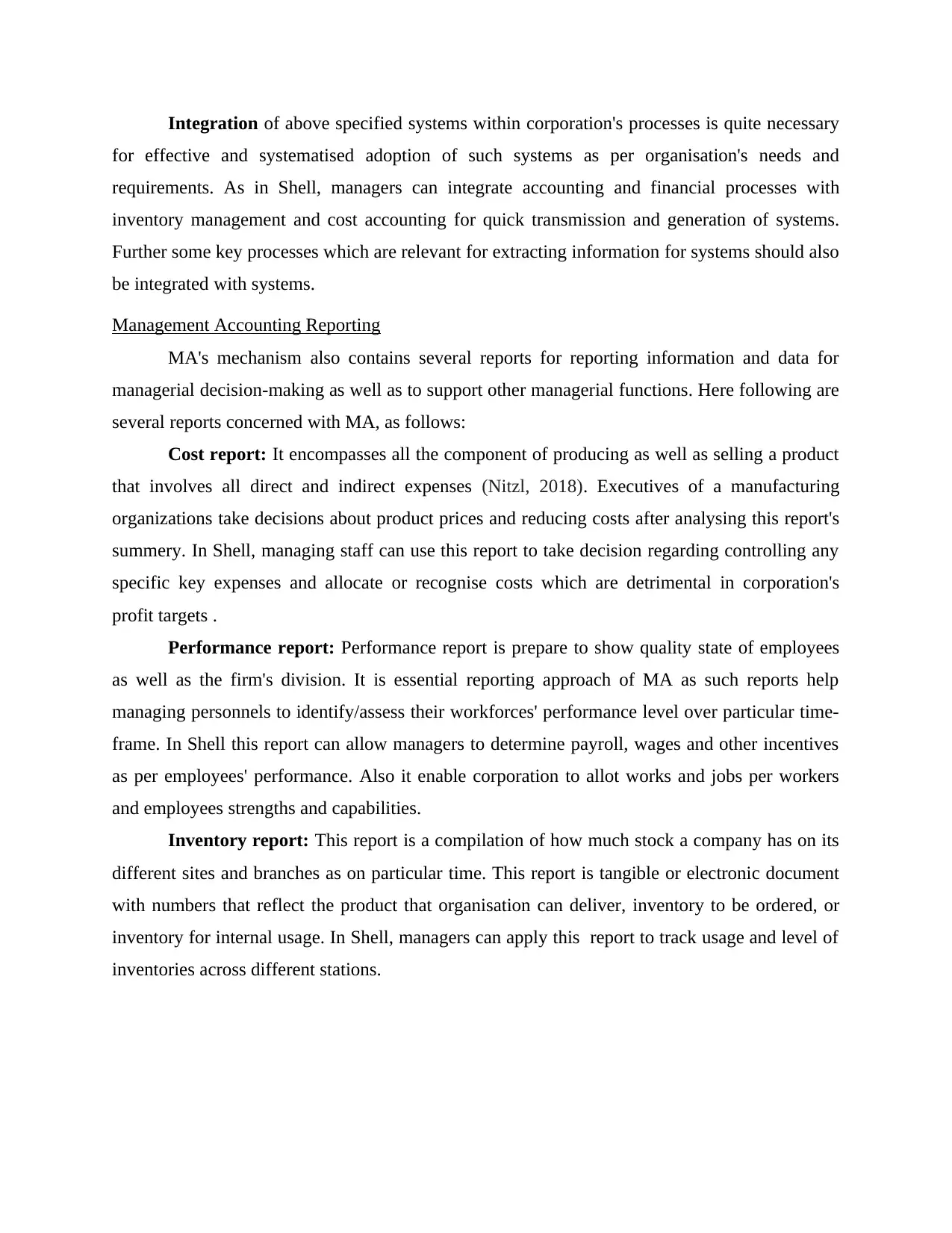
Integration of above specified systems within corporation's processes is quite necessary
for effective and systematised adoption of such systems as per organisation's needs and
requirements. As in Shell, managers can integrate accounting and financial processes with
inventory management and cost accounting for quick transmission and generation of systems.
Further some key processes which are relevant for extracting information for systems should also
be integrated with systems.
Management Accounting Reporting
MA's mechanism also contains several reports for reporting information and data for
managerial decision-making as well as to support other managerial functions. Here following are
several reports concerned with MA, as follows:
Cost report: It encompasses all the component of producing as well as selling a product
that involves all direct and indirect expenses (Nitzl, 2018). Executives of a manufacturing
organizations take decisions about product prices and reducing costs after analysing this report's
summery. In Shell, managing staff can use this report to take decision regarding controlling any
specific key expenses and allocate or recognise costs which are detrimental in corporation's
profit targets .
Performance report: Performance report is prepare to show quality state of employees
as well as the firm's division. It is essential reporting approach of MA as such reports help
managing personnels to identify/assess their workforces' performance level over particular time-
frame. In Shell this report can allow managers to determine payroll, wages and other incentives
as per employees' performance. Also it enable corporation to allot works and jobs per workers
and employees strengths and capabilities.
Inventory report: This report is a compilation of how much stock a company has on its
different sites and branches as on particular time. This report is tangible or electronic document
with numbers that reflect the product that organisation can deliver, inventory to be ordered, or
inventory for internal usage. In Shell, managers can apply this report to track usage and level of
inventories across different stations.
for effective and systematised adoption of such systems as per organisation's needs and
requirements. As in Shell, managers can integrate accounting and financial processes with
inventory management and cost accounting for quick transmission and generation of systems.
Further some key processes which are relevant for extracting information for systems should also
be integrated with systems.
Management Accounting Reporting
MA's mechanism also contains several reports for reporting information and data for
managerial decision-making as well as to support other managerial functions. Here following are
several reports concerned with MA, as follows:
Cost report: It encompasses all the component of producing as well as selling a product
that involves all direct and indirect expenses (Nitzl, 2018). Executives of a manufacturing
organizations take decisions about product prices and reducing costs after analysing this report's
summery. In Shell, managing staff can use this report to take decision regarding controlling any
specific key expenses and allocate or recognise costs which are detrimental in corporation's
profit targets .
Performance report: Performance report is prepare to show quality state of employees
as well as the firm's division. It is essential reporting approach of MA as such reports help
managing personnels to identify/assess their workforces' performance level over particular time-
frame. In Shell this report can allow managers to determine payroll, wages and other incentives
as per employees' performance. Also it enable corporation to allot works and jobs per workers
and employees strengths and capabilities.
Inventory report: This report is a compilation of how much stock a company has on its
different sites and branches as on particular time. This report is tangible or electronic document
with numbers that reflect the product that organisation can deliver, inventory to be ordered, or
inventory for internal usage. In Shell, managers can apply this report to track usage and level of
inventories across different stations.
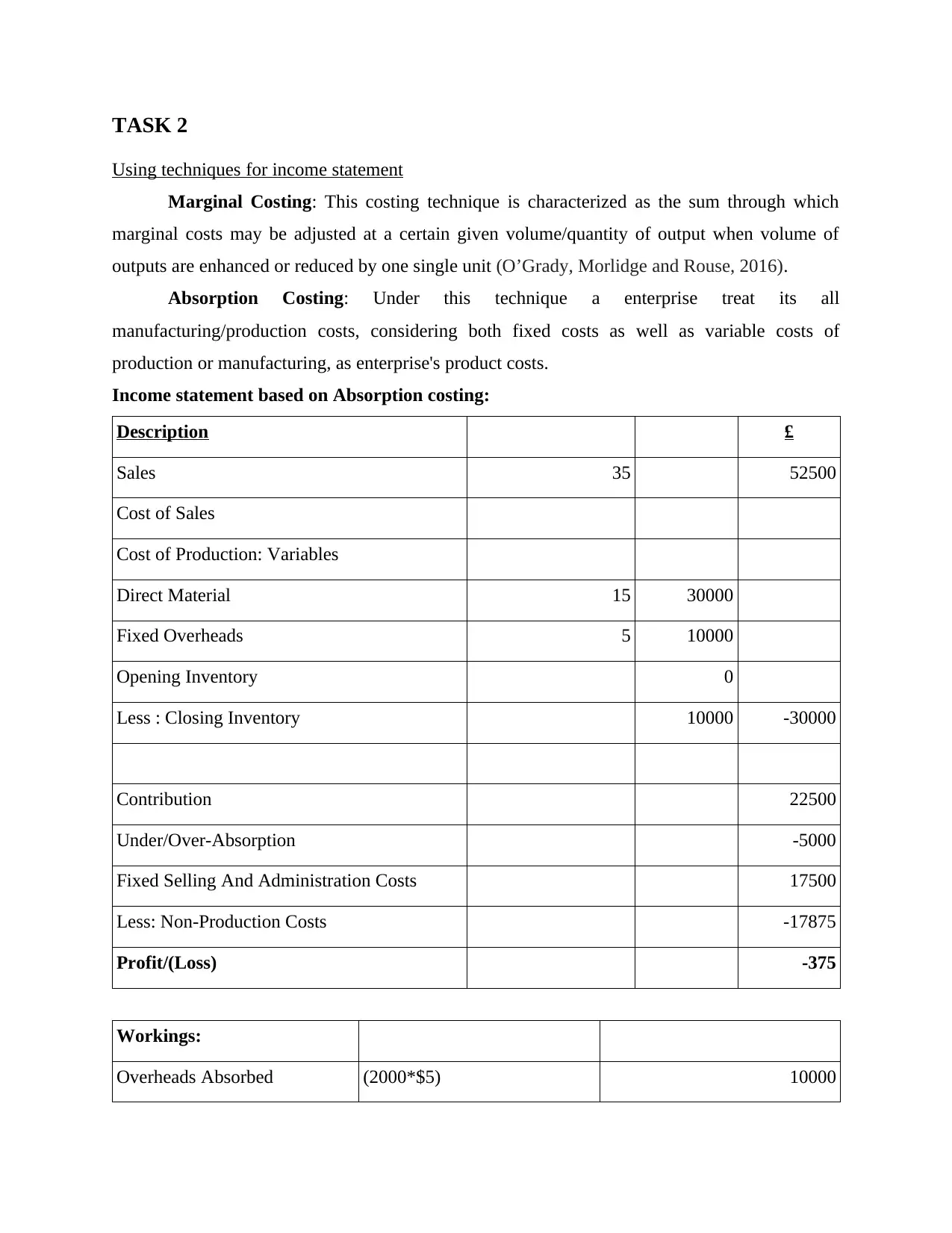
TASK 2
Using techniques for income statement
Marginal Costing: This costing technique is characterized as the sum through which
marginal costs may be adjusted at a certain given volume/quantity of output when volume of
outputs are enhanced or reduced by one single unit (O’Grady, Morlidge and Rouse, 2016).
Absorption Costing: Under this technique a enterprise treat its all
manufacturing/production costs, considering both fixed costs as well as variable costs of
production or manufacturing, as enterprise's product costs.
Income statement based on Absorption costing:
Description £
Sales 35 52500
Cost of Sales
Cost of Production: Variables
Direct Material 15 30000
Fixed Overheads 5 10000
Opening Inventory 0
Less : Closing Inventory 10000 -30000
Contribution 22500
Under/Over-Absorption -5000
Fixed Selling And Administration Costs 17500
Less: Non-Production Costs -17875
Profit/(Loss) -375
Workings:
Overheads Absorbed (2000*$5) 10000
Using techniques for income statement
Marginal Costing: This costing technique is characterized as the sum through which
marginal costs may be adjusted at a certain given volume/quantity of output when volume of
outputs are enhanced or reduced by one single unit (O’Grady, Morlidge and Rouse, 2016).
Absorption Costing: Under this technique a enterprise treat its all
manufacturing/production costs, considering both fixed costs as well as variable costs of
production or manufacturing, as enterprise's product costs.
Income statement based on Absorption costing:
Description £
Sales 35 52500
Cost of Sales
Cost of Production: Variables
Direct Material 15 30000
Fixed Overheads 5 10000
Opening Inventory 0
Less : Closing Inventory 10000 -30000
Contribution 22500
Under/Over-Absorption -5000
Fixed Selling And Administration Costs 17500
Less: Non-Production Costs -17875
Profit/(Loss) -375
Workings:
Overheads Absorbed (2000*$5) 10000
⊘ This is a preview!⊘
Do you want full access?
Subscribe today to unlock all pages.

Trusted by 1+ million students worldwide
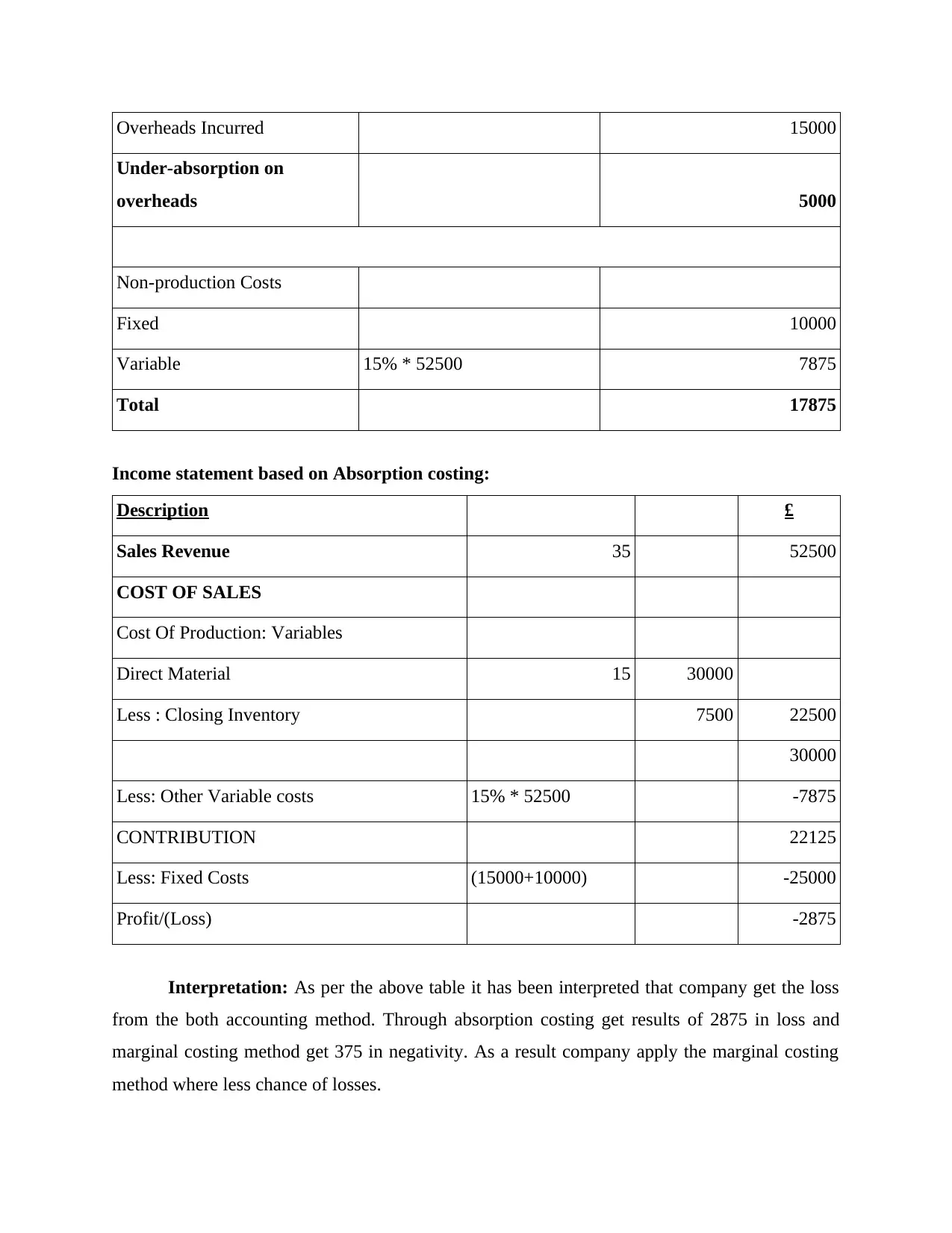
Overheads Incurred 15000
Under-absorption on
overheads 5000
Non-production Costs
Fixed 10000
Variable 15% * 52500 7875
Total 17875
Income statement based on Absorption costing:
Description £
Sales Revenue 35 52500
COST OF SALES
Cost Of Production: Variables
Direct Material 15 30000
Less : Closing Inventory 7500 22500
30000
Less: Other Variable costs 15% * 52500 -7875
CONTRIBUTION 22125
Less: Fixed Costs (15000+10000) -25000
Profit/(Loss) -2875
Interpretation: As per the above table it has been interpreted that company get the loss
from the both accounting method. Through absorption costing get results of 2875 in loss and
marginal costing method get 375 in negativity. As a result company apply the marginal costing
method where less chance of losses.
Under-absorption on
overheads 5000
Non-production Costs
Fixed 10000
Variable 15% * 52500 7875
Total 17875
Income statement based on Absorption costing:
Description £
Sales Revenue 35 52500
COST OF SALES
Cost Of Production: Variables
Direct Material 15 30000
Less : Closing Inventory 7500 22500
30000
Less: Other Variable costs 15% * 52500 -7875
CONTRIBUTION 22125
Less: Fixed Costs (15000+10000) -25000
Profit/(Loss) -2875
Interpretation: As per the above table it has been interpreted that company get the loss
from the both accounting method. Through absorption costing get results of 2875 in loss and
marginal costing method get 375 in negativity. As a result company apply the marginal costing
method where less chance of losses.
Paraphrase This Document
Need a fresh take? Get an instant paraphrase of this document with our AI Paraphraser
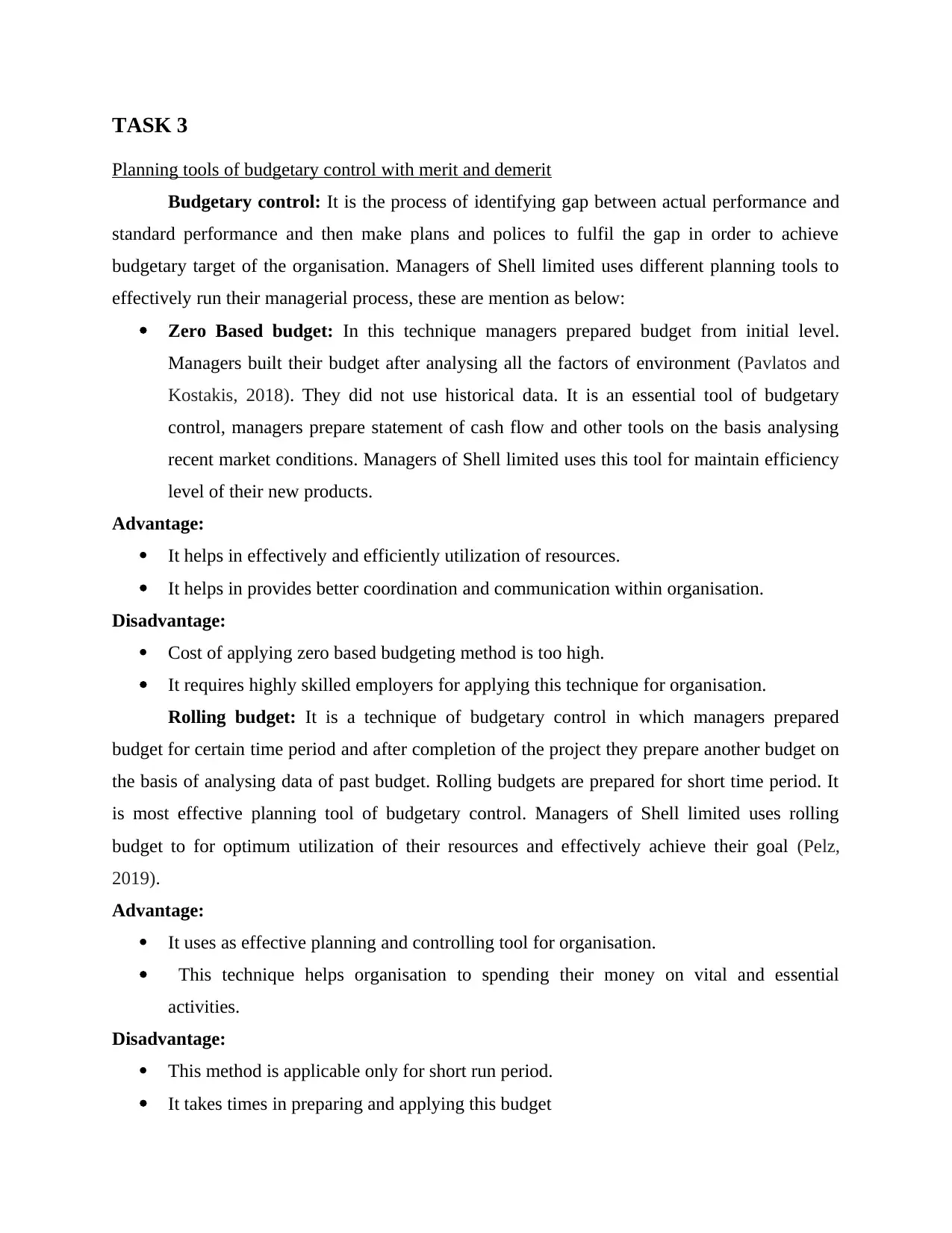
TASK 3
Planning tools of budgetary control with merit and demerit
Budgetary control: It is the process of identifying gap between actual performance and
standard performance and then make plans and polices to fulfil the gap in order to achieve
budgetary target of the organisation. Managers of Shell limited uses different planning tools to
effectively run their managerial process, these are mention as below:
Zero Based budget: In this technique managers prepared budget from initial level.
Managers built their budget after analysing all the factors of environment (Pavlatos and
Kostakis, 2018). They did not use historical data. It is an essential tool of budgetary
control, managers prepare statement of cash flow and other tools on the basis analysing
recent market conditions. Managers of Shell limited uses this tool for maintain efficiency
level of their new products.
Advantage:
It helps in effectively and efficiently utilization of resources.
It helps in provides better coordination and communication within organisation.
Disadvantage:
Cost of applying zero based budgeting method is too high.
It requires highly skilled employers for applying this technique for organisation.
Rolling budget: It is a technique of budgetary control in which managers prepared
budget for certain time period and after completion of the project they prepare another budget on
the basis of analysing data of past budget. Rolling budgets are prepared for short time period. It
is most effective planning tool of budgetary control. Managers of Shell limited uses rolling
budget to for optimum utilization of their resources and effectively achieve their goal (Pelz,
2019).
Advantage:
It uses as effective planning and controlling tool for organisation.
This technique helps organisation to spending their money on vital and essential
activities.
Disadvantage:
This method is applicable only for short run period.
It takes times in preparing and applying this budget
Planning tools of budgetary control with merit and demerit
Budgetary control: It is the process of identifying gap between actual performance and
standard performance and then make plans and polices to fulfil the gap in order to achieve
budgetary target of the organisation. Managers of Shell limited uses different planning tools to
effectively run their managerial process, these are mention as below:
Zero Based budget: In this technique managers prepared budget from initial level.
Managers built their budget after analysing all the factors of environment (Pavlatos and
Kostakis, 2018). They did not use historical data. It is an essential tool of budgetary
control, managers prepare statement of cash flow and other tools on the basis analysing
recent market conditions. Managers of Shell limited uses this tool for maintain efficiency
level of their new products.
Advantage:
It helps in effectively and efficiently utilization of resources.
It helps in provides better coordination and communication within organisation.
Disadvantage:
Cost of applying zero based budgeting method is too high.
It requires highly skilled employers for applying this technique for organisation.
Rolling budget: It is a technique of budgetary control in which managers prepared
budget for certain time period and after completion of the project they prepare another budget on
the basis of analysing data of past budget. Rolling budgets are prepared for short time period. It
is most effective planning tool of budgetary control. Managers of Shell limited uses rolling
budget to for optimum utilization of their resources and effectively achieve their goal (Pelz,
2019).
Advantage:
It uses as effective planning and controlling tool for organisation.
This technique helps organisation to spending their money on vital and essential
activities.
Disadvantage:
This method is applicable only for short run period.
It takes times in preparing and applying this budget
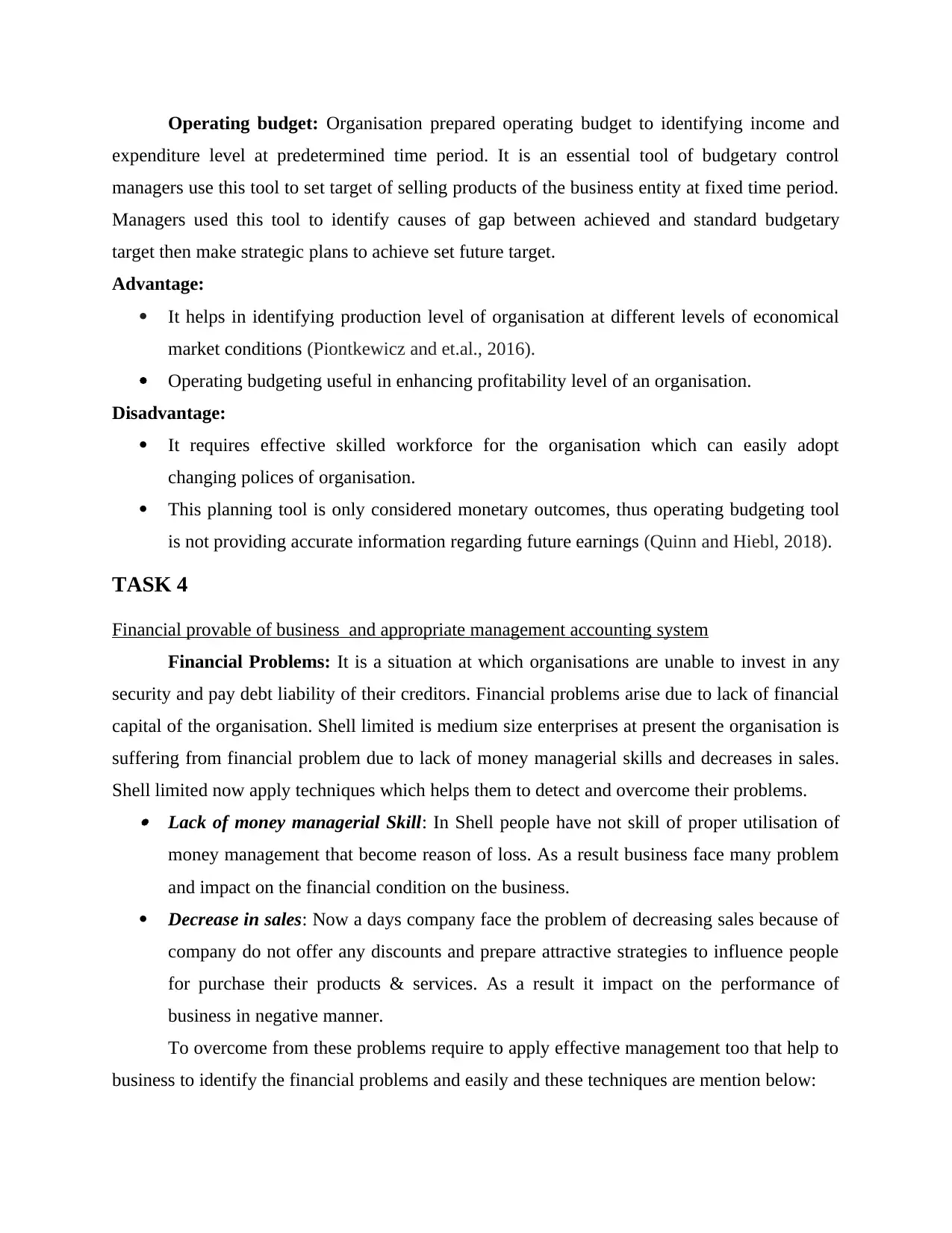
Operating budget: Organisation prepared operating budget to identifying income and
expenditure level at predetermined time period. It is an essential tool of budgetary control
managers use this tool to set target of selling products of the business entity at fixed time period.
Managers used this tool to identify causes of gap between achieved and standard budgetary
target then make strategic plans to achieve set future target.
Advantage:
It helps in identifying production level of organisation at different levels of economical
market conditions (Piontkewicz and et.al., 2016).
Operating budgeting useful in enhancing profitability level of an organisation.
Disadvantage:
It requires effective skilled workforce for the organisation which can easily adopt
changing polices of organisation.
This planning tool is only considered monetary outcomes, thus operating budgeting tool
is not providing accurate information regarding future earnings (Quinn and Hiebl, 2018).
TASK 4
Financial provable of business and appropriate management accounting system
Financial Problems: It is a situation at which organisations are unable to invest in any
security and pay debt liability of their creditors. Financial problems arise due to lack of financial
capital of the organisation. Shell limited is medium size enterprises at present the organisation is
suffering from financial problem due to lack of money managerial skills and decreases in sales.
Shell limited now apply techniques which helps them to detect and overcome their problems. Lack of money managerial Skill: In Shell people have not skill of proper utilisation of
money management that become reason of loss. As a result business face many problem
and impact on the financial condition on the business.
Decrease in sales: Now a days company face the problem of decreasing sales because of
company do not offer any discounts and prepare attractive strategies to influence people
for purchase their products & services. As a result it impact on the performance of
business in negative manner.
To overcome from these problems require to apply effective management too that help to
business to identify the financial problems and easily and these techniques are mention below:
expenditure level at predetermined time period. It is an essential tool of budgetary control
managers use this tool to set target of selling products of the business entity at fixed time period.
Managers used this tool to identify causes of gap between achieved and standard budgetary
target then make strategic plans to achieve set future target.
Advantage:
It helps in identifying production level of organisation at different levels of economical
market conditions (Piontkewicz and et.al., 2016).
Operating budgeting useful in enhancing profitability level of an organisation.
Disadvantage:
It requires effective skilled workforce for the organisation which can easily adopt
changing polices of organisation.
This planning tool is only considered monetary outcomes, thus operating budgeting tool
is not providing accurate information regarding future earnings (Quinn and Hiebl, 2018).
TASK 4
Financial provable of business and appropriate management accounting system
Financial Problems: It is a situation at which organisations are unable to invest in any
security and pay debt liability of their creditors. Financial problems arise due to lack of financial
capital of the organisation. Shell limited is medium size enterprises at present the organisation is
suffering from financial problem due to lack of money managerial skills and decreases in sales.
Shell limited now apply techniques which helps them to detect and overcome their problems. Lack of money managerial Skill: In Shell people have not skill of proper utilisation of
money management that become reason of loss. As a result business face many problem
and impact on the financial condition on the business.
Decrease in sales: Now a days company face the problem of decreasing sales because of
company do not offer any discounts and prepare attractive strategies to influence people
for purchase their products & services. As a result it impact on the performance of
business in negative manner.
To overcome from these problems require to apply effective management too that help to
business to identify the financial problems and easily and these techniques are mention below:
⊘ This is a preview!⊘
Do you want full access?
Subscribe today to unlock all pages.

Trusted by 1+ million students worldwide
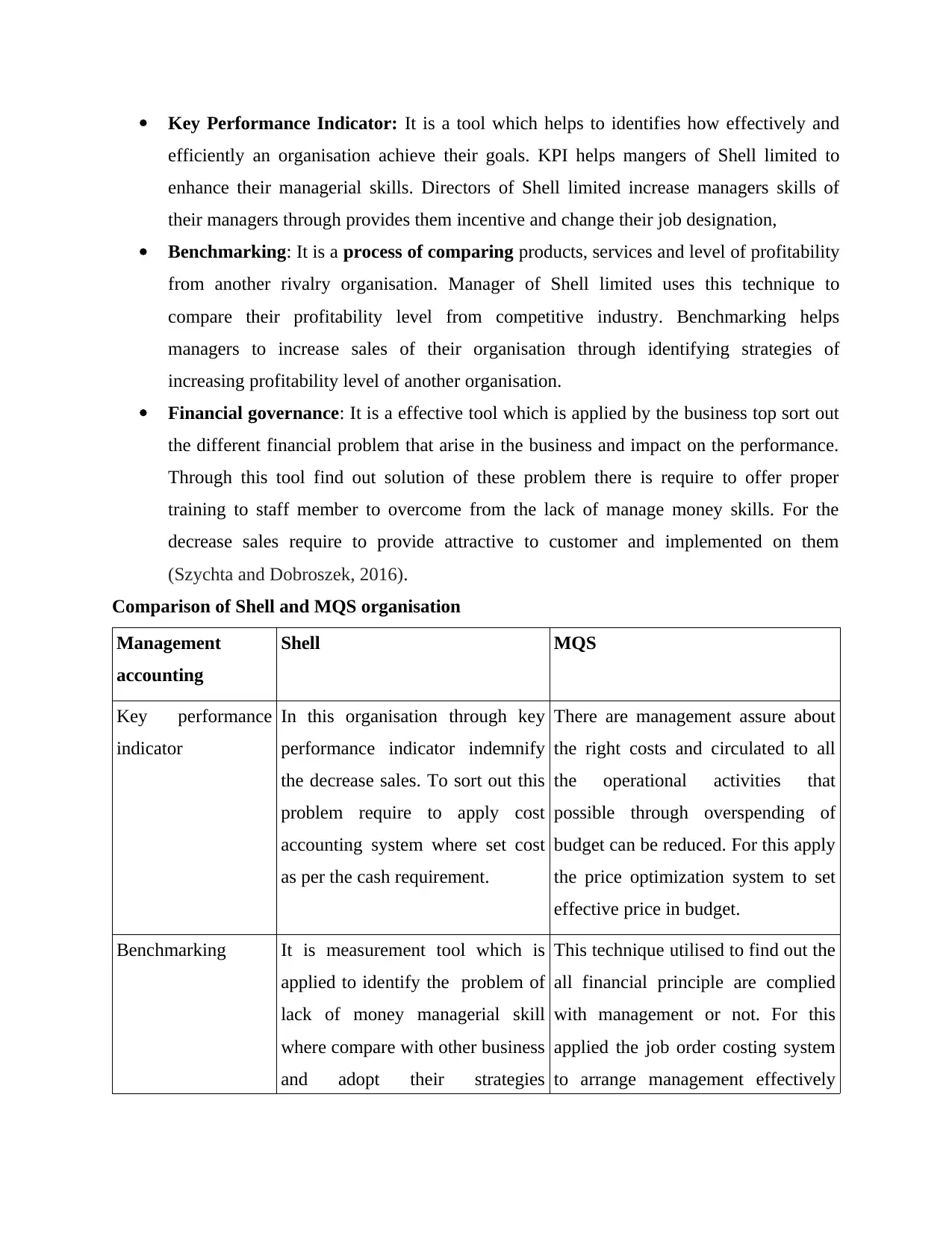
Key Performance Indicator: It is a tool which helps to identifies how effectively and
efficiently an organisation achieve their goals. KPI helps mangers of Shell limited to
enhance their managerial skills. Directors of Shell limited increase managers skills of
their managers through provides them incentive and change their job designation,
Benchmarking: It is a process of comparing products, services and level of profitability
from another rivalry organisation. Manager of Shell limited uses this technique to
compare their profitability level from competitive industry. Benchmarking helps
managers to increase sales of their organisation through identifying strategies of
increasing profitability level of another organisation.
Financial governance: It is a effective tool which is applied by the business top sort out
the different financial problem that arise in the business and impact on the performance.
Through this tool find out solution of these problem there is require to offer proper
training to staff member to overcome from the lack of manage money skills. For the
decrease sales require to provide attractive to customer and implemented on them
(Szychta and Dobroszek, 2016).
Comparison of Shell and MQS organisation
Management
accounting
Shell MQS
Key performance
indicator
In this organisation through key
performance indicator indemnify
the decrease sales. To sort out this
problem require to apply cost
accounting system where set cost
as per the cash requirement.
There are management assure about
the right costs and circulated to all
the operational activities that
possible through overspending of
budget can be reduced. For this apply
the price optimization system to set
effective price in budget.
Benchmarking It is measurement tool which is
applied to identify the problem of
lack of money managerial skill
where compare with other business
and adopt their strategies
This technique utilised to find out the
all financial principle are complied
with management or not. For this
applied the job order costing system
to arrange management effectively
efficiently an organisation achieve their goals. KPI helps mangers of Shell limited to
enhance their managerial skills. Directors of Shell limited increase managers skills of
their managers through provides them incentive and change their job designation,
Benchmarking: It is a process of comparing products, services and level of profitability
from another rivalry organisation. Manager of Shell limited uses this technique to
compare their profitability level from competitive industry. Benchmarking helps
managers to increase sales of their organisation through identifying strategies of
increasing profitability level of another organisation.
Financial governance: It is a effective tool which is applied by the business top sort out
the different financial problem that arise in the business and impact on the performance.
Through this tool find out solution of these problem there is require to offer proper
training to staff member to overcome from the lack of manage money skills. For the
decrease sales require to provide attractive to customer and implemented on them
(Szychta and Dobroszek, 2016).
Comparison of Shell and MQS organisation
Management
accounting
Shell MQS
Key performance
indicator
In this organisation through key
performance indicator indemnify
the decrease sales. To sort out this
problem require to apply cost
accounting system where set cost
as per the cash requirement.
There are management assure about
the right costs and circulated to all
the operational activities that
possible through overspending of
budget can be reduced. For this apply
the price optimization system to set
effective price in budget.
Benchmarking It is measurement tool which is
applied to identify the problem of
lack of money managerial skill
where compare with other business
and adopt their strategies
This technique utilised to find out the
all financial principle are complied
with management or not. For this
applied the job order costing system
to arrange management effectively
Paraphrase This Document
Need a fresh take? Get an instant paraphrase of this document with our AI Paraphraser
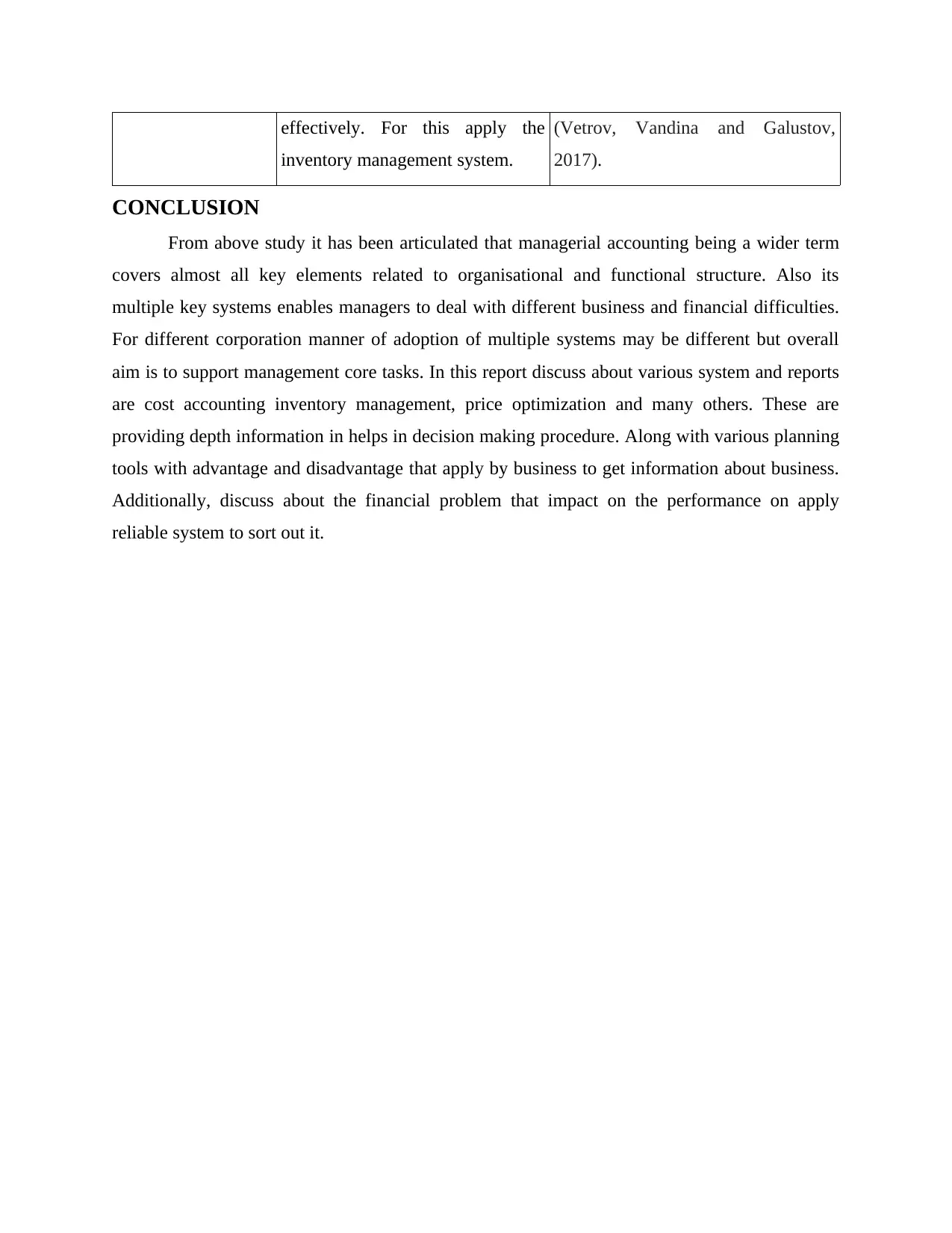
effectively. For this apply the
inventory management system.
(Vetrov, Vandina and Galustov,
2017).
CONCLUSION
From above study it has been articulated that managerial accounting being a wider term
covers almost all key elements related to organisational and functional structure. Also its
multiple key systems enables managers to deal with different business and financial difficulties.
For different corporation manner of adoption of multiple systems may be different but overall
aim is to support management core tasks. In this report discuss about various system and reports
are cost accounting inventory management, price optimization and many others. These are
providing depth information in helps in decision making procedure. Along with various planning
tools with advantage and disadvantage that apply by business to get information about business.
Additionally, discuss about the financial problem that impact on the performance on apply
reliable system to sort out it.
inventory management system.
(Vetrov, Vandina and Galustov,
2017).
CONCLUSION
From above study it has been articulated that managerial accounting being a wider term
covers almost all key elements related to organisational and functional structure. Also its
multiple key systems enables managers to deal with different business and financial difficulties.
For different corporation manner of adoption of multiple systems may be different but overall
aim is to support management core tasks. In this report discuss about various system and reports
are cost accounting inventory management, price optimization and many others. These are
providing depth information in helps in decision making procedure. Along with various planning
tools with advantage and disadvantage that apply by business to get information about business.
Additionally, discuss about the financial problem that impact on the performance on apply
reliable system to sort out it.
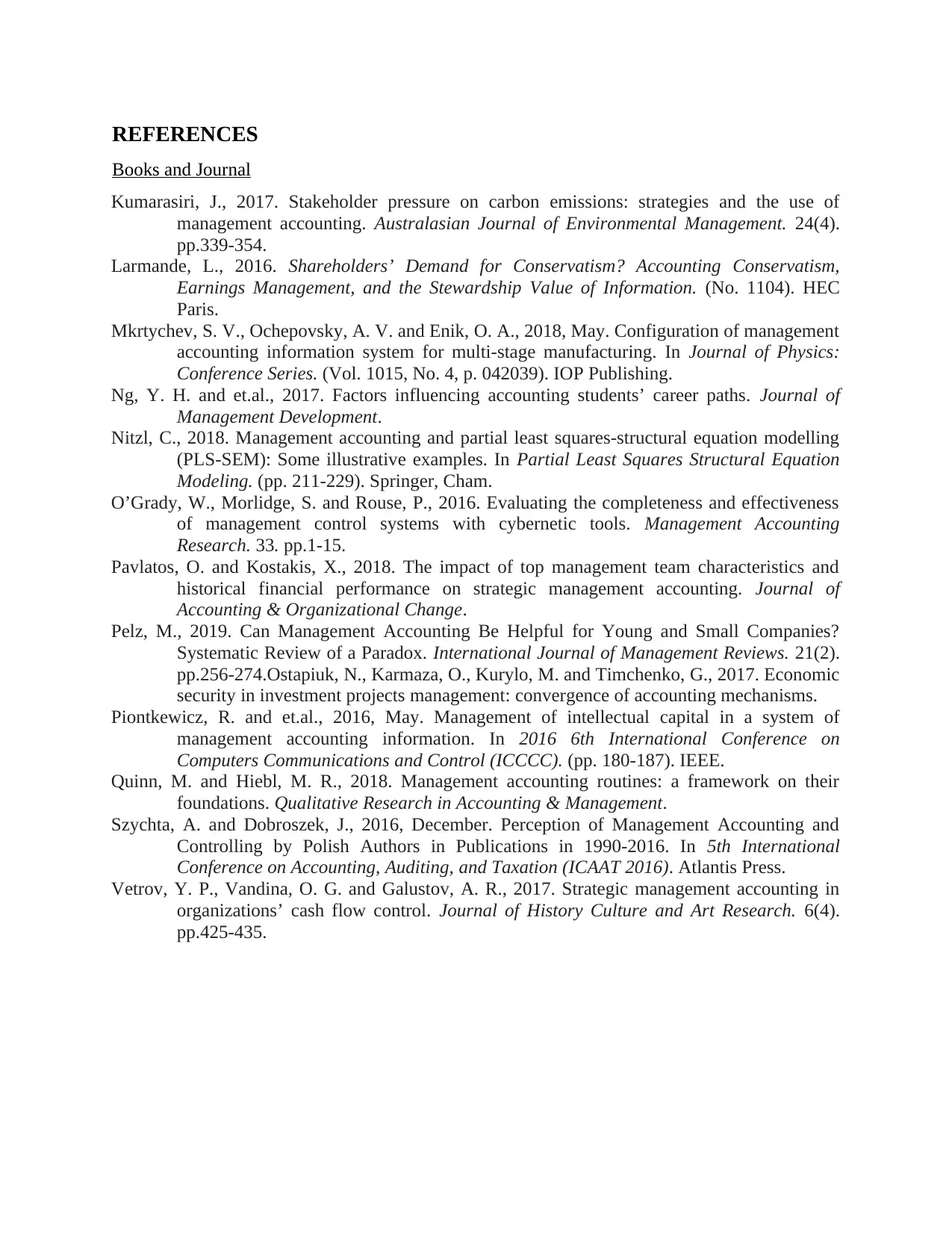
REFERENCES
Books and Journal
Kumarasiri, J., 2017. Stakeholder pressure on carbon emissions: strategies and the use of
management accounting. Australasian Journal of Environmental Management. 24(4).
pp.339-354.
Larmande, L., 2016. Shareholders’ Demand for Conservatism? Accounting Conservatism,
Earnings Management, and the Stewardship Value of Information. (No. 1104). HEC
Paris.
Mkrtychev, S. V., Ochepovsky, A. V. and Enik, O. A., 2018, May. Configuration of management
accounting information system for multi-stage manufacturing. In Journal of Physics:
Conference Series. (Vol. 1015, No. 4, p. 042039). IOP Publishing.
Ng, Y. H. and et.al., 2017. Factors influencing accounting students’ career paths. Journal of
Management Development.
Nitzl, C., 2018. Management accounting and partial least squares-structural equation modelling
(PLS-SEM): Some illustrative examples. In Partial Least Squares Structural Equation
Modeling. (pp. 211-229). Springer, Cham.
O’Grady, W., Morlidge, S. and Rouse, P., 2016. Evaluating the completeness and effectiveness
of management control systems with cybernetic tools. Management Accounting
Research. 33. pp.1-15.
Pavlatos, O. and Kostakis, X., 2018. The impact of top management team characteristics and
historical financial performance on strategic management accounting. Journal of
Accounting & Organizational Change.
Pelz, M., 2019. Can Management Accounting Be Helpful for Young and Small Companies?
Systematic Review of a Paradox. International Journal of Management Reviews. 21(2).
pp.256-274.Ostapiuk, N., Karmaza, O., Kurylo, M. and Timchenko, G., 2017. Economic
security in investment projects management: convergence of accounting mechanisms.
Piontkewicz, R. and et.al., 2016, May. Management of intellectual capital in a system of
management accounting information. In 2016 6th International Conference on
Computers Communications and Control (ICCCC). (pp. 180-187). IEEE.
Quinn, M. and Hiebl, M. R., 2018. Management accounting routines: a framework on their
foundations. Qualitative Research in Accounting & Management.
Szychta, A. and Dobroszek, J., 2016, December. Perception of Management Accounting and
Controlling by Polish Authors in Publications in 1990-2016. In 5th International
Conference on Accounting, Auditing, and Taxation (ICAAT 2016). Atlantis Press.
Vetrov, Y. P., Vandina, O. G. and Galustov, A. R., 2017. Strategic management accounting in
organizations’ cash flow control. Journal of History Culture and Art Research. 6(4).
pp.425-435.
Books and Journal
Kumarasiri, J., 2017. Stakeholder pressure on carbon emissions: strategies and the use of
management accounting. Australasian Journal of Environmental Management. 24(4).
pp.339-354.
Larmande, L., 2016. Shareholders’ Demand for Conservatism? Accounting Conservatism,
Earnings Management, and the Stewardship Value of Information. (No. 1104). HEC
Paris.
Mkrtychev, S. V., Ochepovsky, A. V. and Enik, O. A., 2018, May. Configuration of management
accounting information system for multi-stage manufacturing. In Journal of Physics:
Conference Series. (Vol. 1015, No. 4, p. 042039). IOP Publishing.
Ng, Y. H. and et.al., 2017. Factors influencing accounting students’ career paths. Journal of
Management Development.
Nitzl, C., 2018. Management accounting and partial least squares-structural equation modelling
(PLS-SEM): Some illustrative examples. In Partial Least Squares Structural Equation
Modeling. (pp. 211-229). Springer, Cham.
O’Grady, W., Morlidge, S. and Rouse, P., 2016. Evaluating the completeness and effectiveness
of management control systems with cybernetic tools. Management Accounting
Research. 33. pp.1-15.
Pavlatos, O. and Kostakis, X., 2018. The impact of top management team characteristics and
historical financial performance on strategic management accounting. Journal of
Accounting & Organizational Change.
Pelz, M., 2019. Can Management Accounting Be Helpful for Young and Small Companies?
Systematic Review of a Paradox. International Journal of Management Reviews. 21(2).
pp.256-274.Ostapiuk, N., Karmaza, O., Kurylo, M. and Timchenko, G., 2017. Economic
security in investment projects management: convergence of accounting mechanisms.
Piontkewicz, R. and et.al., 2016, May. Management of intellectual capital in a system of
management accounting information. In 2016 6th International Conference on
Computers Communications and Control (ICCCC). (pp. 180-187). IEEE.
Quinn, M. and Hiebl, M. R., 2018. Management accounting routines: a framework on their
foundations. Qualitative Research in Accounting & Management.
Szychta, A. and Dobroszek, J., 2016, December. Perception of Management Accounting and
Controlling by Polish Authors in Publications in 1990-2016. In 5th International
Conference on Accounting, Auditing, and Taxation (ICAAT 2016). Atlantis Press.
Vetrov, Y. P., Vandina, O. G. and Galustov, A. R., 2017. Strategic management accounting in
organizations’ cash flow control. Journal of History Culture and Art Research. 6(4).
pp.425-435.
⊘ This is a preview!⊘
Do you want full access?
Subscribe today to unlock all pages.

Trusted by 1+ million students worldwide
1 out of 12
Related Documents
Your All-in-One AI-Powered Toolkit for Academic Success.
+13062052269
info@desklib.com
Available 24*7 on WhatsApp / Email
![[object Object]](/_next/static/media/star-bottom.7253800d.svg)
Unlock your academic potential
Copyright © 2020–2025 A2Z Services. All Rights Reserved. Developed and managed by ZUCOL.





